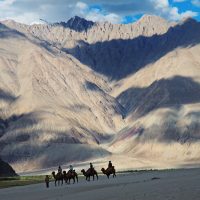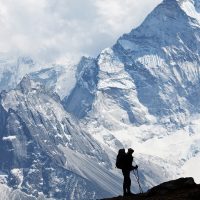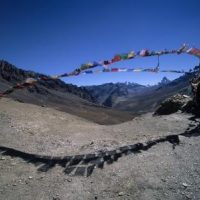 The remote Nubra Valley lies 150km north of Ley in the Indian Himalaya and is the perfect destination for a remote mountain school expedition. Here we look at one sample itinerary we have just put together for Exeter School, but the possibilities in this region are almost limitless with untold trekking options and many peaks ranging from 5,000m to 6,000m.
The remote Nubra Valley lies 150km north of Ley in the Indian Himalaya and is the perfect destination for a remote mountain school expedition. Here we look at one sample itinerary we have just put together for Exeter School, but the possibilities in this region are almost limitless with untold trekking options and many peaks ranging from 5,000m to 6,000m.
Expedition overview:
Getting to the Nubra Valley is an experience in itself. The route here from Leh crosses the Khardung La pass which, at 5,596m, is the highest driveable pass in the world. Once in the Nubra Valley, Exeter School will be undertaking a major 10 day trek, with the possibility of summiting a variety of peaks. Either side of the trekking phase the group will be helping to build a greenhouse for a local village as part of the excellent Eco-sphere project. With winter temperatures often dropping to minus 20C, such thermally efficient greenhouses can ensure families are able to grow crops year round in this high altitude desert. Also on the itinerary is white-water rafting, a visit to the magnificent Taj Mahal and time in bustling New Delhi.
Detailed itinerary:
Please note: this is purely a suggested itinerary and can be tailored to your requirements. If you are interested in arranging an expedition here then contact us to discuss your options.
Days 1-2
International flight to Delhi, India’s capital. Have a day to recover from your flight in Delhi, India’s noisy, dusty, busy yet fantastically vibrant capital.
Day 3
Take an early flight to Leh – the capital city of Ladakh. The flight takes us over the Greater Himalaya and makes an exciting landing at one of the highest airports in the world. Leh is at an altitude of nearly 3,350m, and you can expect to feel the effects of the rarefied atmosphere, so everyone is advised to take it easy for the first day or two and drink lots of water.
 Days 4-5 Acclimatisation
Days 4-5 Acclimatisation
Spend two days in Leh (3600M) acclimatising to the altitude. You can wander the narrow streets, visit the cultural centre or head up to the monastery. On day two start to prepare for your project phase.
Days 6-8 Eco-Sphere Project
During the project you will be helping build and construct an Ecosphere (http://www.spitiecosphere.com) greenhouse just outside of Leh.
During the 3 days before the trek, work will include mixing the mud and water together to make the mortar for the building, laying bricks and using the traditional rammed earth techniques on the mortar bed to build the walls up to waist height. At this point the walls need time to harden while you are trekking before building any higher.
Day 9 Leh to Kyagar
Drive to Nubra valley crossing the Khardungla in our 4 x 4 vehicles, at 18,360ft this is the highest pass in the world that is crossable by vehicles. We will spend the next 2 nights camping here and visiting a neighbouring school in Sumur.
Day 10 Sumar School
Today we will meet with local school children, share their lessons and take on the challenge of playing games at altitude.
Important Trek Note: The follow trek and summit attempt description is a sample of what is possible in the Nubra Valley. The exact route taken and summit attempted will depend on the fitness and capability of the group. This will be evaluated by the leadership team on the trek into the region. The Nubra Valley is a tough trekking environment and the group will need to be fit to attempt any trekking here.
Day 11 Hundar to Skarchen.
In the morning we will meet our trek mule team who will carry our heavy loads while we have a day sack with our water, lunch and spare clothes. From Hundar, we take the trail following the river to the bridge after which we climb gently in a narrow and impressive gorge till a long plateau from where we reach the ruins of the Hundar Dok village at 4100m.
The trail gets a bit narrow and steep till Dzongpa and then continues along the side valley which opens out at the highest point between Hundar and Skarchen. We continue to Skarchen approx 3800m at the confluence of 2 streams in the gorge. This walk will take us 6 hours through the gorge on an undulating path. On a clear day 6000m peaks of the Hundar Valley can be seen.

Day 12 Skarchen to Hundar Dok.
We continue along the gorge passing Wacham, a small settlement of 2 families. We cross the river by bridge and continue gradually up to the beautiful pastures of Dok Yongma, a small village with 5 to 6 households. We continue on a good village path to Hundar Dok where we camp close to the river. It's a short day but the afternoon can be spent in the village meeting the local people. 4 ½ hrs.
Day 13 Sniu Sumdo valley ( 4400m)
Today begins with a lovely walk through the Thanglasgo valley to the junction of the Thanglasgo and Sniu Sumdo valley. We trek into the Sniu Sumdo valley and camp close to the glacial lake. These are summer pastures of the villagers of Nubra. – 5/ 6hrs
Day 14 Advance camp of Kangsalmathung (5123m).
We trek past Tsochen, a glacial lake and climb gradually to our advance camp of Kangsalmathung. The horses will leave us at the lake from where we will continue with only the necessary supplies as loads would have to be ferried. After the lake we walk through moraine and a short tricky section on boulders, passing another small lake before camp. 4 hrs.
Day 15 Rest day.
After the rigour of the trek we can relax today and have a lie in. We will walk up to the base of the glacier to practice walking with our crampons and axes.
 Day 16 Kangsalmathung (5700m)
Day 16 Kangsalmathung (5700m)
We will leave camp in the dark by 4am after a light breakfast and with packed lunch and snacks. We begin with a climb on moraine for about 2 hours and then reach the glacier. We rope up here into parties of 3 each with a mountain guide. We put on our crampons and climb gradually for about an hour after which the slope is gentler for a while. Finally we climb gradually until the last 80m which gets quite steep. – 6 hours to the summit of Kangsalmathung (5700m). Descend to camp – another 3 hours.
Day 17 Descend to Sniu Sumdo.
Today we retrace our steps to camp at the lake at Sniu Sumdo.
Day 18 Jhingmoche, 4500m
After breakfast we continue our descent to the junction of the Sniu Sumdo and Thanglasgo valleys. From here we continue the gradual climb across the pastures, which are carpeted with flowers. We follow a stream for another 5 – 6 hours to camp near Thanglasgo or a little further to Jhingmoche (4500m).
Day 19 The base of Lasermola at 4800m.
During the summer months, shepherds bring their sheep, yaks, Dzomos for grazing and they live in temporary summer huts here. There is a tradition that just 2-3 families from the village of Hundar Dok come here every summer with the animals of all the villagers for grazing and whilst here, they make cheese and butter for the villagers.
They stay here until the end of August/September and return to their village for the harvesting season. A very pleasant walk again today, camping in a beautiful spot on the banks of a river at the head of the valley. 5 / 6 hrs
 Day 20Lasermola Pass 5400m/ Phyiang
Day 20Lasermola Pass 5400m/ Phyiang
Leaving the pastures we keep climbing to the snow line and moraine until the top of the Lasermola pass 5400m taking approximately 2 – 3 hours to the top. At the pass we are rewarded with excellent views of the Karakoram Mountains and Zanskar range of mountains and valleys on both sides. For those who are still not tired they can go on a little further up from the pass for even better views of Stok Kangri.
There will be snow at the pass and we would need to leave camp very early in the morning to make the crossing easier for the animals. From the pass, you descend the Phyiang valley to camp at 4500m above Phyiang village. 7 hours.
 Days 21 White water rafting
Days 21 White water rafting
We meet our vehicles and head back to Ley, taking in a diversion to white-water raft down the Indus from Upshi to Choglamsar – this is close to the Holy Residence.
Days 22-24 Return to Project
Travel back to the project site and continue with your work. By now the walls will have hardened and you can continue building the greenhouse.
Once the walls are completed they then need to be rendered and left to dry ready for painting. Continue working on the roof, windows and doors of the greenhouse with the aim of completing the greenhouse before you leave the project site.
 Days 25-26 Delhi & Agra
Days 25-26 Delhi & Agra
Depart Leh and return to Delhi by internal flight. From here you can visit Agra home to the famous Taj Mahal, and spend your last day in Delhi visiting the sites; Red Fort, Qutb complex, Huyan’s tomb as well as souvenir hunting in the bazaars.
Days 27-28 Head for home
Depart Delhi and arrive back in the UK. Welcome home.
